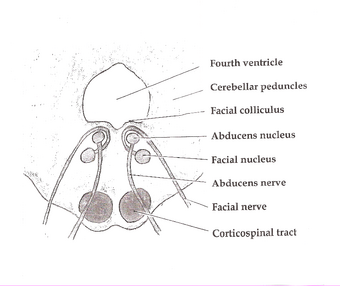Medicine:Medial pontine syndrome
From HandWiki
| Medial pontine syndrome | |
|---|---|
 | |
| Pons. (Medial pontine syndrome affects structures at the bottom of the diagram: the corticospinal tract, abducens nerve, and occasionally the facial nerve. Medial lemniscus is also affected, but not pictured.) |
Medial inferior pontine syndrome is a condition associated with a contralateral hemiplegia.[citation needed]"Medial inferior pontine syndrome" has been described as equivalent to Foville's syndrome.[1]
Presentation
Although medial pontine syndrome has many similarities to medial medullary syndrome, because it is located higher up the brainstem in the pons, it affects a different set of cranial nuclei.[citation needed]
| Structure affected | Presentation |
|---|---|
| Corticospinal tract | Contralateral spastic hemiparesis |
| Medial lemniscus | Contralateral PCML (aka DCML) pathway loss (tactile, vibration, and stereognosis) |
| Abducens nerve | Strabismus (ipsilateral lateral rectus muscle paralysis - the affected eye looks down and towards the nose). Abducens nerve lesion localizes the lesion to inferior pons. |
Depending upon the size of the infarct, it can also involve the facial nerve.
Cause

Medial pontine syndrome results from occlusion of paramedian branches of the basilar artery.[citation needed]
Diagnosis
Treatment
See also
- Alternating hemiplegia of childhood
- Lateral medullary syndrome
- Lateral pontine syndrome
- Medial medullary syndrome
- Weber's syndrome
References
- ↑ "A rare case of diplopia: medial inferior pontine syndrome or Foville's syndrome". Eur J Emerg Med 3 (3): 194–8. September 1996. doi:10.1097/00063110-199609000-00011. PMID 9023501.
External links
| Classification |
|---|
 |

